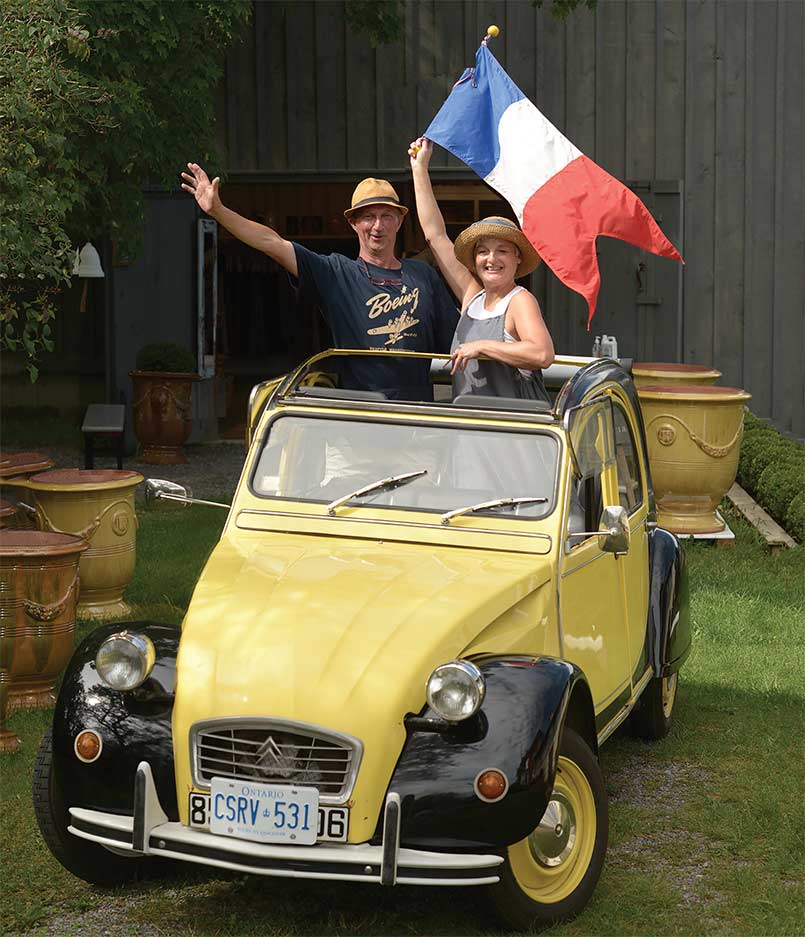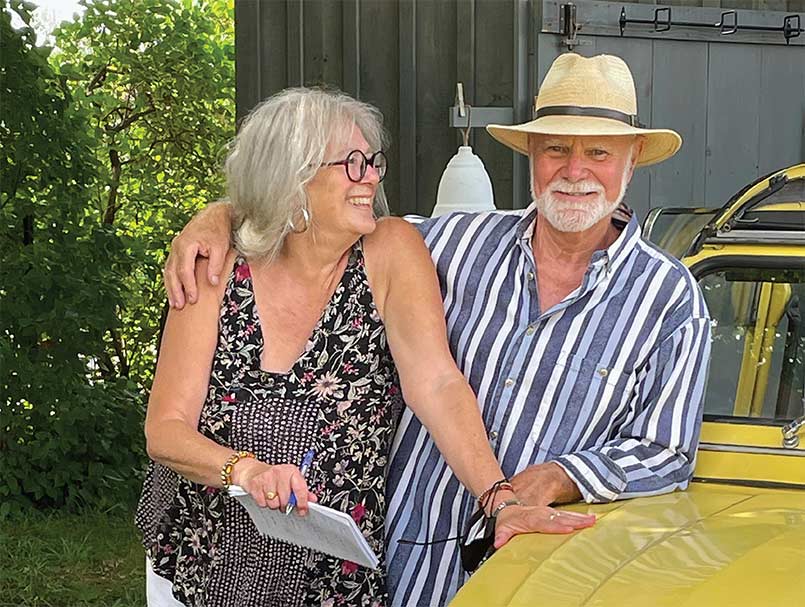

Janet and Graham Davies
A beloved automobile takes its devotees on a ride into the past
Artisans Françoise Méchin Pellet and Thierry Méchin moved to Prince Edward County from France by way of Montreal, and their home in Milford feels like un petit morceau de Provence – a little piece of Provence. There’s lavender in the garden, pastis in the glass, French antiques and linens in the barn. And a yellow and black Citroën 2CV in the driveway.
Françoise dreamed of owning a 2CV all her life and laughs to think she finally acquired one in Canada. She had hoped to get one for her 50th birthday, but moving to Quebec, then the County and re-establishing their business meant the idea kept sliding down their list. “We had no budget,” she says sadly. “They are very expensive in France and in Canada, too.” But they did have friends with a 2CV, and a couple of years ago they were carousing around the countryside in it when the car broke down at the Grange Winery. “So they called the guy who every 2CV owner calls when they need help,” she says in her beautiful accent. And that’s how they first met Bernard Laborde, Citroën mechanic extraordinaire and 2CV wizard. Production of the legendary little cars ended in 1990, so his long experience and deep knowledge of them is increasingly valuable. Françoise told him of her dream; months later he called to say he might be able to make it come true. “He said he has one that is very old, but he thinks he can make it go. I said yes please!”
THE 2CV STORY
For admirers of French design and style, the Citroën deux chevaux (literally “two horses”) is about as iconic as it gets. It was created in the 1930s to make motoring accessible to everyone in France. The population was largely rural and the design specs were clearly tailored for farmers still using horses and carts.
The original specifications supplied to Citroën chief designer Pierre-Jules Boulanger:
- “four wheels under an umbrella” – nicely sums up the minimalist vision
- space for 4 adults (and tall enough to take passengers to church in Sunday-best hats)
- big enough to carry 50 kg of potatoes
- within the two-horsepower fiscal bracket
- front-wheel drive
- maximum speed 60 km/h
- 3-speed gear box (in fact there is a supercharger position that acts as a 4th gear)
- easy to maintain
- able to carry a basket of eggs over a rough, ploughed field without breaking any
- fuel consumption of 3 litres per 100 km (about 90 miles to the gallon)
- cheap overall cost of ownership
Even Top Gear, the macho British motoring show, has a soft spot for 2CVs, calling them “lollopy, characterful vehicles … designed to be rugged, useful and affordable.” The lightweight little car is as legendary in France as Ford’s Model T was in America, and, remarkably, kept the same basic design for more than 40 years. It was conceived in the 1930s, but production was delayed by WWII. The Top Gear guys also delight in the fact that Pierre-Jules Boulanger “seriously annoyed” the Nazis by dismantling almost all the prototypes and refusing to share the engineering. The few remaining prototypes were hidden in haylofts or bricked up behind walls, and Boulanger was labelled an enemy of the Reich for his resistance. Cue La Marseillaise.
Production of the 2CV began after the war. In 1949 Citroën was making 4 cars a day, by 1950 it was 400 and over the next 40 years millions were made in France and sold worldwide. The little 2CV never really took off in North America, where big cars were the norm. In 1988 Citroën moved production to Portugal, and in 1990 the last 2CV rolled off the line. But La Deuche’s glory days were not over. There are more than 300 clubs worldwide devoted to the 2CV. It has been called “the most intelligent application of minimalism ever to succeed as a car,” which brings us back to Françoise. She’s a minimalist but likes her minimalism served with quality, style and heart.
THE OWNERS
Françoise and Thierry started L’Atelier du Presbytère in France in 1996. They make classic linen clothes, bags and accessories, sell French antiques and linens and import small quantities of gorgeous ceramics from Provence. Their name comes from their street in Provence, Rue du Presbytère, where they lived near the church in Valabrègues, and a pleasing thread connects their subsequent homes: In Montreal they were on Notre Dame Street West, in Milford they live next door to the village church on St. Philips Street.
Thierry is a carpenter and cabinet maker who also restores old furniture and doors, incorporating vintage hinges, clasps, locks and glass to give them new life. The interior of their new build barn will be embellished with aged timbers and architectural salvage, including the old windows from their house in Provence. “We knew the buyers would just throw them away,” says Françoise, “so we took them out and put in modern windows.” The drafty old windows crossed the Atlantic with their other treasures and will go into a dividing wall between their workshop and retail space, “so people can see where the work gets done.”
Huge ceramic urns stand outside the shop, glazed in rich earth colours. The photographer thinks it will be fun if they climb into them, and they cheerfully comply. Françoise keeps up a running commentary as she clambers in, clutching her dress and laughing. After the shoot, Thierry brings out a tray bearing a ceramic jug of water and a bottle of blackberry cordial with an insanely beautiful label – so stylish, so simple, so French.
THE CAR
The 2CV that Bernard found was very old indeed, a 1977 model. Françoise is particular about her clothes and surroundings; she’s a natural curator, and favours shades of blue and grey. “I was not sure I wanted a bright yellow car,” she says with a little frown. But the car was a Charleston, the two-tone 2CV inspired by Art Deco, and was very yellow and black. Françoise is particular but pragmatic, too. “Now I like it very much. It matches our sign!” she says happily, referring to the cheery yellow sun at the bottom of the driveway.
For admirers of French design, the Citroën deux chevaux (literally “two horses”) is about as iconic as it gets.
The car arrived in time for her 55th birthday. “Thierry turns sixty this year, so we say it is a present for two,” she says. She’s very proud that their Charleston was truly made in France. “Because it is so old it was made in Le Valois, not Portugal,” she says. “We don’t have the big budgets but we can boast about that, non?”
Do they drive it? “But of course!” she says in surprise. “We use it carefully, but we use it a lot because it is fun! We do our grocery shopping in it.” It can after all hold 50 kg of potatoes and get your eggs home safe. But they won’t be driving it in winter. “We will put it away,” she says sensibly, giving it a loving pat on its tinny little hood.
Full disclosure, the photographer and writer have a soft spot for Citroën 2CVs. They owned one in England before moving to Canada. In fact they owned two, because the first one was as old as Françoise’s and its life with them was short but happy. Theirs were two-tone, too. They sat in Françoise and Thierry’s little car with the canvas top rolled back and felt a big wave of nostalgia. They say 2CVs make people smile, and the evidence suggests that’s true.
Story by:
Janet Davies
Photography by:
Graham Davies


